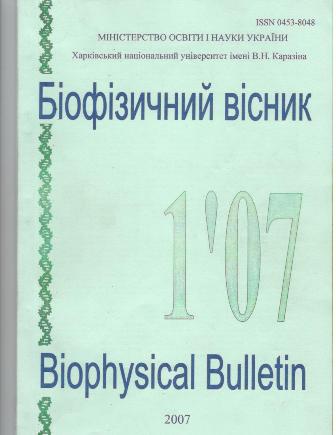Effect of chlorpromazine low concentrations on human erythrocyte distribution by spherical index and on time period of hypotonic hemolysis
Abstract
The possible consequences of the chlorpromazine (CP) effect at low concentrations after its incorporation into erythrocyte membranes were analyzed. Erythrocyte distribution by spherical index and the rate of hemolysis in the hypotonic medium were studied at 0.125 mM and 0.25 mM CP. The investigation showed the non-uniform response of erythrocytes from different donors to CP introduced into suspension. Samples were divided into two groups according to their reaction to CP. In the first group of donors, the CP introduction invokes a full or partial shift of the distribution curves towards larger values of the spherical index. In the second group, CP introduction resulted in the increase of cell density in low spherical index interval. Thus, the interaction of amphiphile substances with a membrane bilayer can evoke controversial effects. One of the possible effects of CP is the intercalation of alkyl regions into the membrane bilayer. This can lead to an increase in membrane surface. On the other hand amphiphile incorporation into lipid bilayer can lead to the formation of inverted micelles. In this case the membrane surface diminishes comparing to the native one at the expense of transition of a part of membrane material to the described phase. Thus, both membrane surface stretching and constriction phenomena are equally probable in the examined CP concentration interval and depend on the population state of a donor.
Downloads
References
Schneider E. Bacterial cytotoxins amphotericin B and local anesthetics enhance transbilayer mobility of phospholipids in membrane. Consequences for phospholipid asymmetry. Biochim. Biophys. Acta. 1986;855:325-36.
Hagerstand H, Isomaa B. Amphiphile-induced antihaemolysis is not causally related to shape changes and vesiculation. Chem. Biol. Interact. 1991;79:335-47.
Gordienko OI, Gordienko YuE, Makedonska VO. Estimation of erythrocyte population state by spherical index distribution. Bioelectrochemistry. 2004;62:119-22.
Kovalenko SE. Possible Mechanisms of Chlorpromazine Antihemolytic Effect. Problems of Cryobiology. 2006;16:136-47.
Seeman P. The membrane action of anesthetics and tranquilizers. Pharmacol. Rev. 1972;24:583-655
Gordienko EA, Gordienko YuE, Gordienko OI. The physico-mathematical theory of human erythrocyte hypotonic hemolysis phenomenon. Cryo-Letters. 2003;24:229-44.
Authors who publish with this journal agree to the following terms:
- Authors retain copyright and grant the journal right of first publication with the work simultaneously licensed under a Creative Commons Attribution License that allows others to share the work with an acknowledgement of the work's authorship and initial publication in this journal.
- Authors are able to enter into separate, additional contractual arrangements for the non-exclusive distribution of the journal's published version of the work (e.g., post it to an institutional repository or publish it in a book), with an acknowledgement of its initial publication in this journal.
- Authors are permitted and encouraged to post their work online (e.g., in institutional repositories or on their website) prior to and during the submission process, as it can lead to productive exchanges, as well as earlier and greater citation of published work (See The Effect of Open Access).





